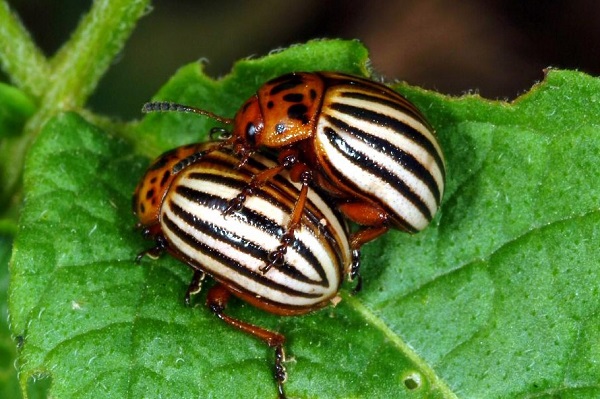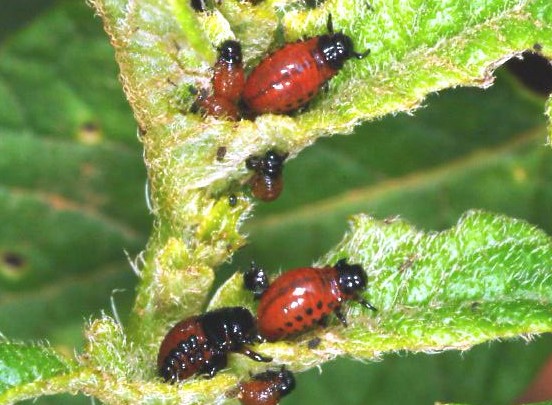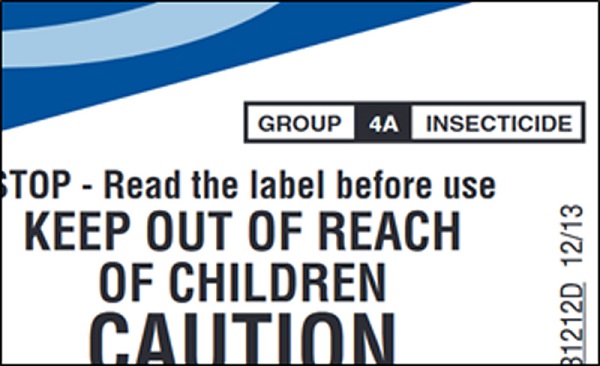Colorado Potato Beetle Management
ENTFACT-312: Colorado Potato Beetle Management | Download PDF
Ric Bessin, Extension Specialist
University of Kentucky College of Agriculture
The common black and yellow-striped "potato bug", a very familiar insect to home gardeners, is the most serious insect pest of potatoes. Both the striped beetle and the black-spotted, red larva feed on potato leaves. Their damage can greatly reduce yield and even kill plants. In addition to potato, Colorado potato beetle can be a serious pest of tomato, eggplant, and pepper.

Figure 1. Colorado potato is commonly referred to as the 'potato bug'.
The Colorado potato beetle is notorious for its ability to rapidly develop resistance to insecticides that are used repeatedly for control. This has been a serious problem on the east coast for some time, and is becoming more of a problem in Kentucky. With a limited number of insecticides available, some homeowners feel they have exhausted their control options when it becomes resistant to one or more insecticides.
Biology
Colorado potato beetles overwinter in the soil as adults. They become active in the spring as temperatures rise and begin to feed on weeds and volunteer or early planted potatoes, even entering the soil to attack emerging foliage. Female beetles lay orange-yellow eggs in batches of about two dozen or so on the underside of the leaves. Each female can lay 500 or more eggs over a four to five week period. Eggs hatch in four to nine days and the larvae begin to feed on potato foliage.
The larvae are humpbacked with two rows of black spots on each side. They usually feed in groups and damage can be severe. The larval stage lasts two to three weeks.

Figure 2. Colorado potato beetle larvae are humpbacked with two rows of black spots on each side of the body.
Full-grown larvae burrow in the ground to pupate. In five to 10 days, the adult beetle emerges. This insect can go from egg to adult in as little as 21 days. The newly emerged adult female feeds for a few days before egg laying begins. There are two full and occasionally a partial third generation each year. If foliar sprays are used, an effort should be made to treat just after most eggs have hatched but before serious plant damage occurs.
Resistance Management
Insecticides in the same chemical class usually have the same mode of action, the same method of killing the insect. Resistance develops more rapidly to an insecticide when that insecticide is used repeatedly as the only control measure. Repeated use of one class kills susceptible beetles, leaving those that are resistant. Overuse of one insecticide may favor the development of resistance to other insecticides in the same chemical class. Consequently, to delay or prevent resistance it is important to avoid repeated usage of one particular insecticide by rotating the insecticides used.
Rotation needs to be among different classes of insecticides. This is done by switching IRAC modes of action groups with each application. For example, rotation between two pyrethroids in IRAC group 3A would not be as effective as a group 3A followed by a group 4A in rotation. Because both group 3A’s are in the same class of chemicals and have the same mode of action, nothing is gained with this type of rotation.

Figure 3. IRAC mode of action group listing is on the front of most commercial insecticide labels.
Bacillius thuringiensis var tenebrionis (Bt) is effective against small larvae (less than 1/4 inch) and should be applied at egg hatch or when larvae are first seen. A premature treatment may lose much of its effectiveness before the eggs hatch. Larger larvae are more difficult to control with Bt. Azatin, an extract of the neem seed, prevents the larvae from developing normally.
Frequently, control failures with Colorado potato beetle are due to other factors besides just insecticide resistance alone. Timing of sprays is critical for control. Overwintering beetles are attracted to fields over a period of several weeks; spraying an insecticide too early may only control a portion of those beetles. However, waiting until larvae are nearly full grown also increases the chances of control failure. Small larvae are much easier to control with an insecticide than large ones. Using the correct amount of insecticide as well as obtaining complete coverage of the plants is important.
Insecticides should only be used when needed. Potato plants can withstand considerable defoliation without yield loss. Plants can loss up to 30% of their foliage without yield loss. Generally, insecticides do not need to be applied unless there is more than an average of one beetle or larva per plant. Additionally, some beneficial insects such as birds, predatory stink bugs, and parasitic flies will help to reduce Colorado potato beetle numbers somewhat.
Other non-chemical control measures such as hand picking of adult beetles and immature stages is encouraged as this will aid to delay the development of resistance. Hand picking can be particularly effective in reducing the numbers of overwintering beetles coming to the young plants in the spring. Resistance by Colorado potato beetles should be managed on a field to field basis. While they may be resistant to one insecticide in a particular location, those in other areas within the same county may not have developed resistance to that insecticide.
Revised: 11/19
CAUTION! Pesticide recommendations in this publication are registered for use in Kentucky, USA ONLY! The use of some products may not be legal in your state or country. Please check with your local county agent or regulatory official before using any pesticide mentioned in this publication.
Of course, ALWAYS READ AND FOLLOW LABEL DIRECTIONS FOR SAFE USE OF ANY PESTICIDE!
Photos courtesy Ric Bessin, University of Kentucky Entomology
